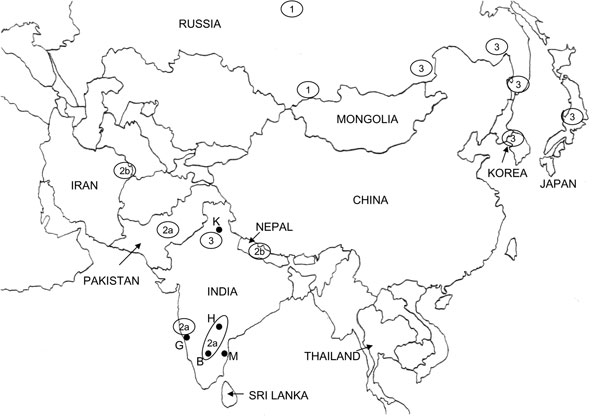Volume 13, Number 1—January 2007
Research
Emergence of Arctic-like Rabies Lineage in India
Figure 3

Figure 3. Map of mainland Asia. The locations from which Arctic and Arctic-like variants of the rabies virus have been recovered are shown in circles or ovals with the group designation (1, 2a, 2b, or 3) indicated in the center. Generation of this map was achieved in part by compiling data from 2 previous publications (19,21). Viral phylogroups previously designated as A and B (21) are equivalent to groups 1 and 3, respectively, in this study. B, Bangalore, G, Goa; H, Hyderabad; K, Kasauli; M, Madras.
References
- World Health Organization. WHO Expert Consultation on Rabies, 2004. Geneva: The Organization; 2005. First report: WHO technical report series #931.
- Smith JS, Orciari LA, Yager PA, Seidel HD, Warner CK. Epidemiologic and historical relationships among 87 rabies virus isolates as determined by limited sequence analysis.J Infect Dis. 1992;166:296–307.PubMedGoogle Scholar
- Fooks AR, Johnson N, Brookes SM, Parsons G, McElhinney LM. Risk factors associated with travel to rabies endemic countries.J Appl Microbiol. 2003;94:31S–6S. DOIPubMedGoogle Scholar
- Solomon T, Marston D, Mallewa M, Felton T, Shaw S, McElhinney L, Paralytic rabies after a two week holiday in India.BMJ. 2005;331:501–3. DOIPubMedGoogle Scholar
- Johnson N, Brookes SM, Fooks AR, Ross RS. Review of human rabies cases in the UK and in Germany.Vet Rec. 2005;157:715.PubMedGoogle Scholar
- Knobel DL, Cleaveland S, Coleman PG, Fèvre EM, Meltzer MI, Miranda MEG, Re-evaluating the burden of rabies in Africa and Asia.Bull World Health Organ. 2005;83:360–8.PubMedGoogle Scholar
- Crepin P, Audry L, Rotivel Y, Gacoin A, Caroff C, Bourhy H. Intravitam diagnosis of human rabies by PCR using saliva and cerebrospinal fluid.J Clin Microbiol. 1998;36:1117–21.PubMedGoogle Scholar
- Elmgren LD, Nadin-Davis SA, Muldoon FT, Wandeler AI. Diagnosis and analysis of a recent case of human rabies in Canada.Can J Infect Dis Med Microbiol. 2002;13:129–33.
- Smith J, McElhinney L, Parsons G, Brink N, Doherty T, Agranoff D, Case report: rapid ante-mortem diagnosis of a human case of rabies imported into the UK from the Philippines.J Med Virol. 2003;69:150–5. DOIPubMedGoogle Scholar
- Smith JS. Molecular epidemiology. In: Jackson AC, Wunner WH, editors. Rabies. San Diego: Academic Press; 2002. p. 79–111.
- Slate D, Rupprecht CE, Rooney JA, Donovan D, Lein DH, Chipman RB. Status of oral rabies vaccination in wild carnivores in the United States.Virus Res. 2005;111:68–76. DOIPubMedGoogle Scholar
- Nadin-Davis SA, Casey GA, Wandeler AI. A molecular epidemiological study of rabies virus in central Ontario and western Quebec.J Gen Virol. 1994;75:2575–83. DOIPubMedGoogle Scholar
- Sudarshan MK, Madhusudana SN, Mahendra BJ, Rao NS, Narayana DH, Rahman SA, Assessing burden of human rabies in India: results of a national multi-centre epidemiological survey. Int J Infect Dis. 2006. [Epub ahead of print].
- Dean DJ, Abelseth MK, Atanasiu P. The fluorescent antibody test. In: Meslin F-X, Kaplan MM, Koprowski H, editors. Laboratory techniques in rabies, 4th ed. Geneva: World Health Organization; 1996. p. 88–95.
- Nadin-Davis SA. Polymerase chain reaction protocols for rabies virus discrimination.J Virol Methods. 1998;75:1–8. DOIPubMedGoogle Scholar
- Thompson JD, Gibson TJ, Plewniak F, Jeanmougin F, Higgins DG. The CLUSTAL X windows interface: flexible strategies for multiple sequence alignment aided by quality analysis tools.Nucleic Acids Res. 1997;25:4876–82. DOIPubMedGoogle Scholar
- Felsenstein J. PHYLIP: phylogeny inference package (version 3.52c). Seattle (WA): University of Washington; 1993.
- Page RD. TREEVIEW: an application to display phylogenetic trees on personal computers.Comput Appl Biosci. 1996;12:357–8.PubMedGoogle Scholar
- Mansfield KL, Racloz V, McElhinney LM, Marston DA, Johnson N, Ronsholt L, Molecular epidemiological study of Arctic rabies virus isolates from Greenland and comparison with isolates from throughout the Arctic and Baltic regions.Virus Res. 2006;116:1–10. DOIPubMedGoogle Scholar
- Nadin-Davis SA, Simani S, Armstrong J, Fayaz A, Wandeler AI. Molecular and antigenic characterization of rabies viruses from Iran identifies variants with distinct epidemiological origins.Epidemiol Infect. 2003;131:777–90. DOIPubMedGoogle Scholar
- Kuzmin IV, Botvinkin AD, McElhinney LM, Smith JS, Orciari LA, Hughes GJ, Molecular epidemiology of terrestrial rabies in the former Soviet Union.J Wildl Dis. 2004;40:617–31.PubMedGoogle Scholar
- Hyun BH, Lee KK, Kim IJ, Lee KW, Park HJ, Lee OS, Molecular epidemiology of rabies virus isolates from South Korea.Virus Res. 2005;114:113–25. DOIPubMedGoogle Scholar
- Park YJ, Shin MK, Kwon HM. Genetic characterisation of rabies virus isolates in Korea.Virus Genes. 2005;30:341–7. DOIPubMedGoogle Scholar
- Zhang YZ, Xiong CL, Zou Y, Wang DM, Jiang RJ, Xiao QY, Molecular characterization of rabies virus isolates in China during 2004.Virus Res. 2006;121:179–88. DOIPubMedGoogle Scholar
- Tabel H, Corner AH, Webster WA, Casey GA. History and epizootiology of rabies in Canada.Can Vet J. 1974;15:271–81.PubMedGoogle Scholar
- Nadin-Davis SA, Muldoon F, Wandeler AI. Persistence of genetic variants of the arctic fox strain of rabies virus in southern Ontario.Can J Vet Res. 2006;70:11–9.PubMedGoogle Scholar
- Bourhy H, Kissi B, Audry L, Smreczak M, Sadkowska-Todys M, Kulonen K, Ecology and evolution of rabies virus in Europe.J Gen Virol. 1999;80:2545–57.PubMedGoogle Scholar
- Johnson N, Black C, Smith J, Un H, McElhinney LM, Aylan O, Rabies emergence among foxes in Turkey.J Wildl Dis. 2003;39:262–70.PubMedGoogle Scholar
- Suja MS, Mahadevan A, Sundaram C, Mani J, Sagar BC, Hemachudha T, Rabies encephalitis following fox bite—histological and immunohistochemical evaluation of lesions caused by virus.Clin Neuropathol. 2004;23:271–6.PubMedGoogle Scholar
- Jayakumar R, Tirumurugaan KG, Ganga G, Kumanan K, Mahalinga Nainar A. Characterization of nucleoprotein gene sequence of an Indian isolate of rabies virus.Acta Virol. 2004;48:47–50.PubMedGoogle Scholar
- Nanayakkara S, Smith JS, Rupprecht CE. Rabies in Sri Lanka: splendid isolation.Emerg Infect Dis. 2003;9:368–71.PubMedGoogle Scholar
Page created: June 28, 2010
Page updated: June 28, 2010
Page reviewed: June 28, 2010
The conclusions, findings, and opinions expressed by authors contributing to this journal do not necessarily reflect the official position of the U.S. Department of Health and Human Services, the Public Health Service, the Centers for Disease Control and Prevention, or the authors' affiliated institutions. Use of trade names is for identification only and does not imply endorsement by any of the groups named above.